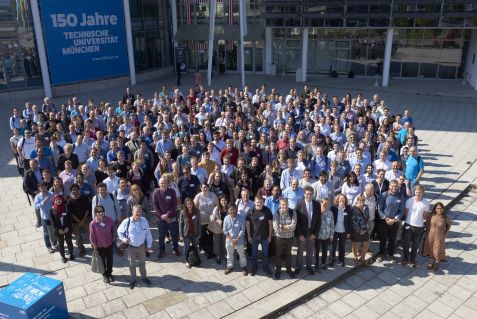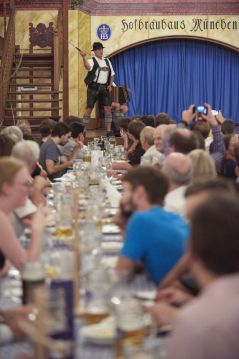MLZ is a cooperation between:
 > Technische Universität München
> Technische Universität München > Helmholtz-Zentrum Hereon
> Helmholtz-Zentrum Hereon
 > Forschungszentrum Jülich
> Forschungszentrum Jülich
MLZ is a member of:
 > LENS
> LENS > ERF-AISBL
> ERF-AISBL
MLZ on social media:

MLZ (eng)
Lichtenbergstr.1
85748 Garching
27.09.2018
SNI 2018: Forschung mit Blick in die Zukunft
A wealth of new contacts, ideas and information was taken home by more than 520 scientists who attended the German Conference for Research with Synchrotron Radiation, Neutrons and Ion Beams at Large Facilities 2018 in mid September 2018.
Three intensive days – many participants even came to the welcome reception on the night before the start of the conference in elegant ambience of the Münchner Künstlerhaus am Lenbachplatz. The conference was organised by the user committees KFS, KFN and KFSI in cooperation with MLZ.
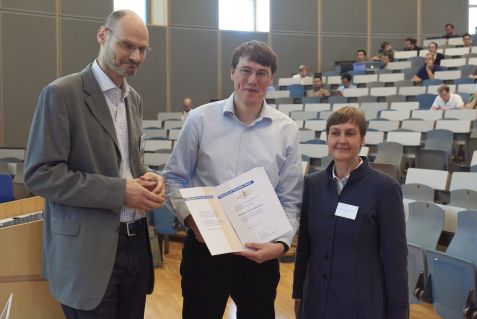
Awarding ceremony of the Wolfram-Prandl-Prize 2018 at the SNI2018 in Garching. Left to right: Prof. Dr. Frank Schreiber (Tübingen University), Dr. Felix Roosen-Runge (Lund University) and Dr. Astrid Schneidewind (FZ Jülich, KFN chair). © W. Schürmann / TUM © W. Schürmann / TUM
The conference was opened by Prof. Dr. Peter Müller-Buschbaum in his role as local host from the Technical University of Munich and as scientific director at the Heinz Maier-Leibnitz Zentrum and by Dr. Jürgen Kroseberg from the Bundesministerium für Bildung und Forschung, who pointed out that the meeting is both a showcase of research on matter and the universe at large facilities and a meeting of an active scientific community. The next highlight was the public evening lecture by Prof. Dr. Tim Salditt on the possibilities of research with Synchrotron Radiation, Neutrons and Ion Beams.
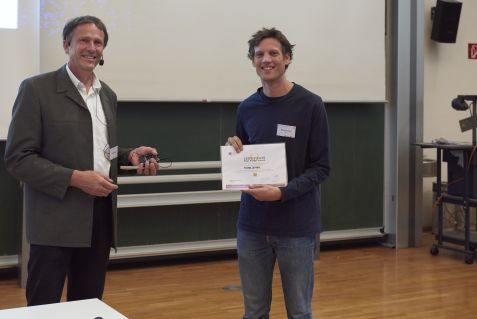
Dr. Michael Leitner (MLZ/TUM) was awarded another poster prize by Prof. Dr. Klaus-Dieter Liss, Guangdong Technion - Israel Institute of Technology. © W. Schürmann / TUM
The numerous topics of the meeting reflects the diversity of the scientific field: functional materials, magnetism, soft matter, life sciences, catalysis, nanomaterials, thin films, surfaces and interfaces, structural biology. Due to the common use of large facilities, methods are an important topic as well. In fact, research in this field lives on the development of methods. Therefore, there were sessions on methods and instrumentation, In-situ and in-operando studies and novel developments in time resolved techniques. Research with synchrotron radiation, neutrons and ion beams is crucial for the understanding of matter and leads to important applications, which became apparent in the innovation and industry session. Many participants took part in the sessions covering future topics: Next generation large scale facilities and digital agenda.
Future projects
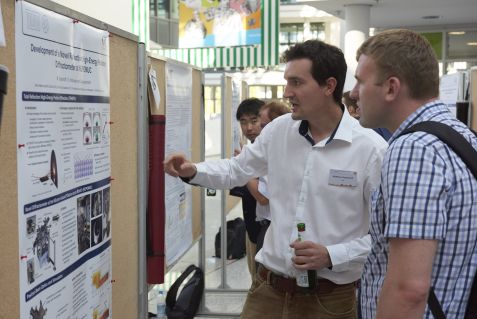
Matthias Dodenhöft (TUM) explaining his poster, which was awarded. © W. Schürmann / TUM
The future has already begun: First experiments at the European XFEL were presented by Robert Feidenhans’l. This extremlely powerful X-ray beam for research was taken into user operation close to Hamburg one year ago. It serves the European user community by providing the possibility for performing new classes of experiments to investigate the structure and dynamics of matter on the atomic length and time scales. The instrumentation of this source is tailored to these specific opportunities, as it is done at the other projects.

Members of the 11. KFN and the 11. KFS user committees at their meeting. © Karin Griewatsch (Univ. Kiel)
Under construction are BESSY VSR at HZB in Berlin, the Extremely Brilliant Source at ESRF (ESRF-EBS) in Grenoble, die European Spallation Source (ESS) in Lund and the Facility for Antiproton and Ion Research in Europe (FAIR) of GSI in Darmstadt and in planning PETRA IV at DESY in Hamburg.
For the first time in the 30 years the committees have been in place, KFS and KFS met before the conference in a joint meeting. As expected, the common needs of synchrotron and neutron users became apparent.
Poster prizes for two scientists from the MLZ
The conference was rounded out by the distinction of young scientists for their excellent research and their presentation. The committee research with neutrons (KFN) awarded the Wolfram-Prandl-Prize 2018 for young researchers to Dr. Felix Roosen-Runge. He received the prize for his outstanding contributions to neutron scattering studies of the phase behavior and dynamics of protein solutions, see https://www.sni-portal.de/kfn/Infos/WPP-Roosen-Runge-engl.php. Poster prizes were awarded to Konstantin Krausert (DESY/University of Hamburg), Dr. Michael Leitner (MLZ/TUM), persuing his habilitation with experiments at the MLZ, and Matthias Dodenhöft (TUM), in his PhD studies at the positron source NEPOMUC of the MLZ.
In four years the active and growing science community will meet again, since the format of the SNI-meetings is so successful.
Wolfram Prandl-Prize
Awarding by: Committee Research with Neutrons
For: Outstanding achievements in the field of neutron scattering
Candidates: Junior scientist under 40
Remuneration: 2500 €
Cycle: Every 2 years within the German Conference on Neutron Scattering.
Named after: Professor Wolfram Prandl (Univ. Tübingen)
MLZ is a cooperation between:
 > Technische Universität München
> Technische Universität München > Helmholtz-Zentrum Hereon
> Helmholtz-Zentrum Hereon
 > Forschungszentrum Jülich
> Forschungszentrum Jülich
MLZ is a member of:
 > LENS
> LENS > ERF-AISBL
> ERF-AISBL
MLZ on social media:



